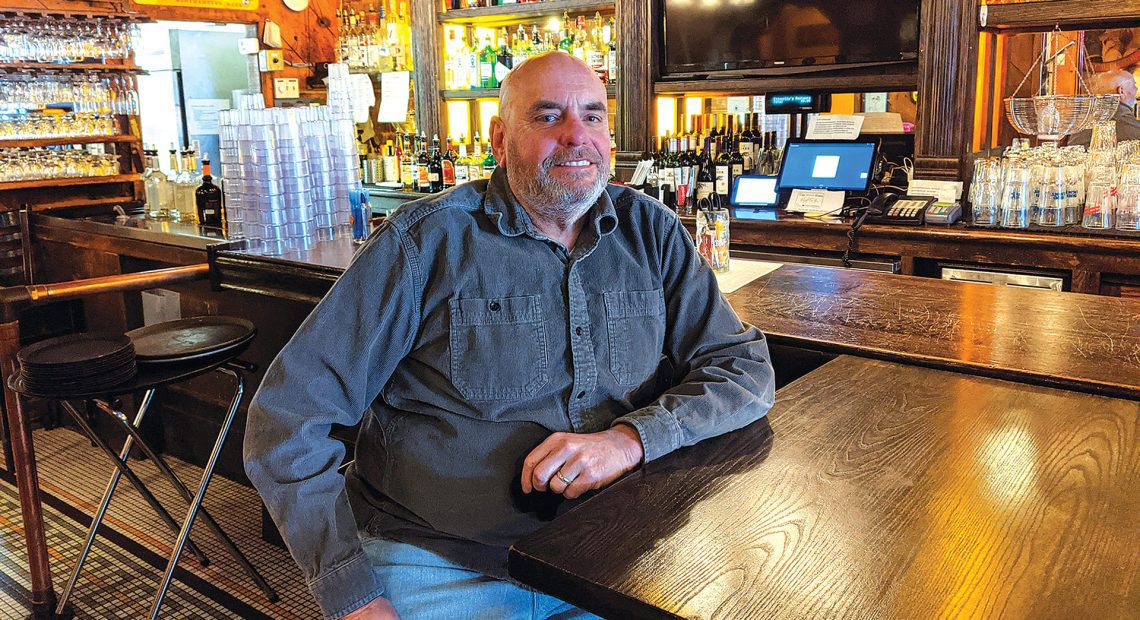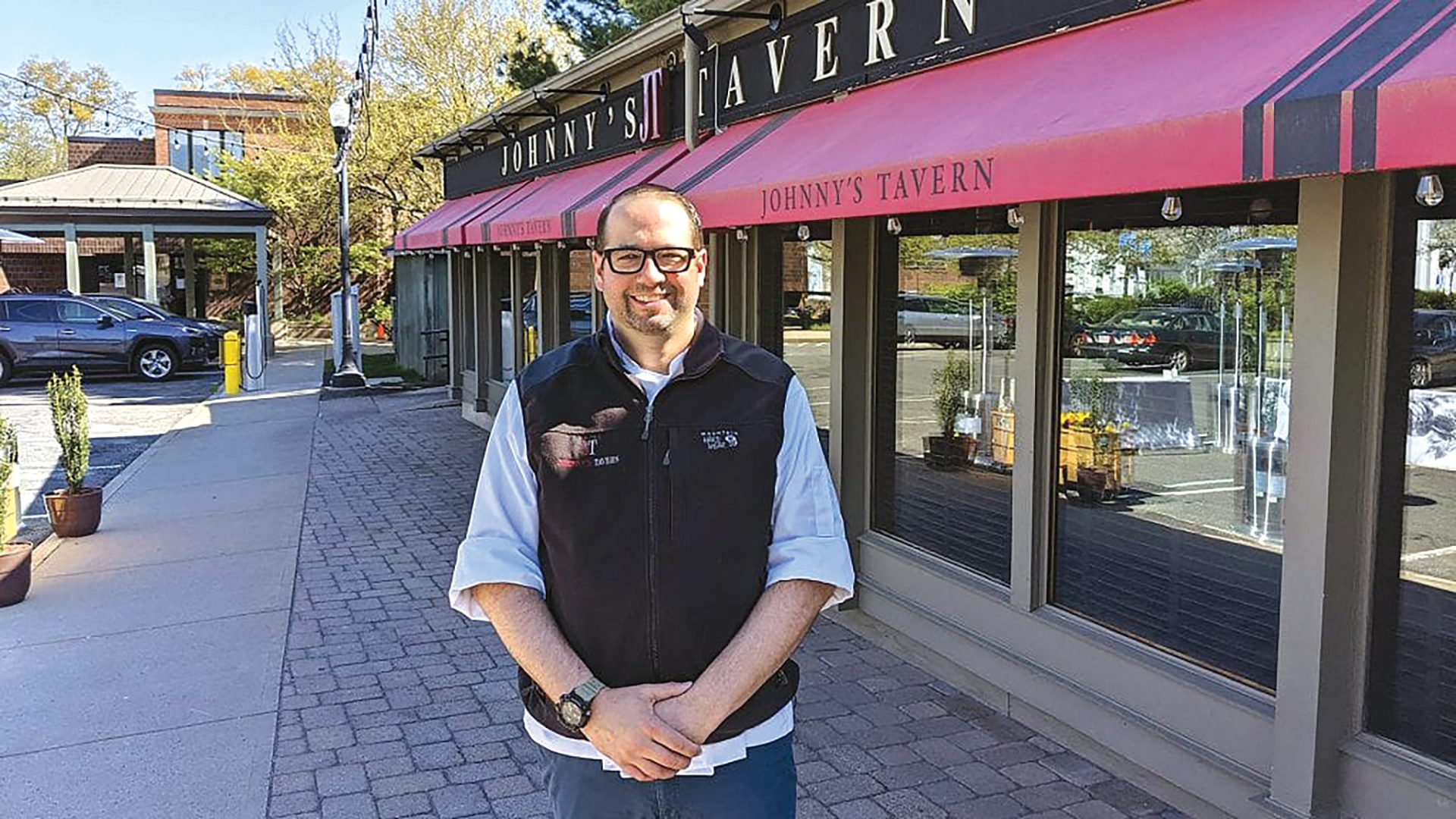
Restaurants Still Navigating Thorny Challenges
Food for Thought

Fred Gohr says the lingering pandemic may extend industry trends both positive (more outdoor dining) and negative (staffing issues).
There’s no doubt that 2021 was a better year for restaurants than 2020, which was marked by weeks of closure in the spring and strict capacity restrictions after that. Many restaurants stayed afloat with expanded takeout and outdoor seating, while looking forward to what they hoped would be a stronger 2021. But while restrictions were lifted and patrons returned last year, other issues — from a workforce shortage and supply issues to new COVID variants — kept the industry from reaching full strength. What’s on the menu in 2022 for this industry so critical to the economic health of Hampshire County? Stay tuned.
By Joseph Bednar and Mark Morris
Fred Gohr recalls thinking, a year ago, that there would be a lot of pent-up demand for eating out in 2021, and he was right.
Which is why it’s a little strange to be thinking the same thoughts again, after a persistent series of COVID-19 surges — the Omicron variant is only the latest — that kept slowing down restaurants’ progress last year.
Still, “we’ve actually done pretty well,” said Gohr, owner of Fitzwilly’s in downtown Northampton. “Fortunately, Fitzwilly’s is pretty large and kind of spread out. We put up plexiglass between all the booths, which a lot of places did; it makes guests certainly feel more comfortable.
“But all in all, 2021 was not a bad year,” he added. “It certainly had ups and downs, peaks and valleys — a few patches that were really rough — but overall, from a business level, we looked back at the end of the year and felt we did better than we thought we would at the beginning of 2021. So that was a pleasant surprise — or relief, whatever you want to call it.”
Restaurants, one of the main economic and tourism drivers in Hampshire County, certainly saw that pent-up demand manifest in 2021, especially after Memorial Day, when the state lifted the final restrictions on gatherings. Most restaurants reported strong summer business. The problem, however — and it’s a big one — came when they realized hospitality workers were leaving the field in droves, and not coming back any time soon.
“I guess the biggest challenge in 2021 was staffing. It was very, very difficult,” Gohr said. “We’re fortunate we have a core of staff who have been here a long time. Most of those folks hung in through the highs and lows and are still here.”
“Probably in late December we noticed a little slowdown because of the resurfacing of Omicron and the changing variants. But overall, it was a very good year.”
Bryan Graham, regional manager for the Bean Restaurant Group, which boasts a family of 11 eateries throughout the region, many in Hampshire County, agreed that staffing has been a challenge even for the most popular restaurants.
“All restaurants across the region are struggling to find hourly cooks, along with a few entry-level positions,” he said. “We definitely had to reshift our labor pool and are taking care of employees with more aggressive wage increases to retain them.”
Edison Yee, president of the Bean Group, agreed with that assessment of the workforce shortage. “It’s still a big part of the picture. We’re definitely focused on the future and retaining our employees, but the general application pool is way down.
“We have guys, hourly employees, with longevity, who love this group, but when someone is offering a $4 hourly increase to them, they have to jump ship a lot of times, unfortunately,” Yee added. “We’ve been giving more increases to employees in the past six months than in prior years.”
The problem has been exacerbated by Omicron, which has kept many employees out of work at establishments around the region, forcing some restaurants to reduce hours or even close for certain days.
All of this affects the bottom line, but so does another global economic issue currently impacting not only restaurants, but industries of all types: supply shortages and costs. For restaurants, that largely means food products, but affects paper products and other supplies as well, Graham said, and it sometimes forces eateries to switch menu items or ingredient brands to keep up with price fluctuations and availability.

Bryan Graham says there’s often “no rhyme or reason” to what products will be harder or more expensive to obtain.
“Products have definitely increased in price. As far as supply goes, it’s hit or miss. We’re still seeing shortages on some of your higher-end meats — prime meats are definitely a little scarce to come by and very expensive — but some other products have come back down in price. There’s no rhyme or reason to it — just the trucking-industry delivery windows of these vendors getting their products in.”
Still, overall in 2021, “we did see a good recovery, with most of our restaurants operating at 2019 levels or a little bit below,” Yee said. “I think we saw a good amount of pent-up demand in 2021, especially in the latter part of the year; through the summer and into fall, we were really busy, traffic-wise. Probably in late December we noticed a little slowdown because of the resurfacing of Omicron and the changing variants. But overall, it was a very good year for our restaurant group in Hampshire County.”
Takeout Takes Off
Amit Kanoujia, general manager of the India House in Northampton, said the pandemic has taught everyone to be nimble and to roll with the punches. His recent renovation of the India House came as the result of winning a liquor-license lottery; when the Sierra Grille closed, that license became available. Kanoujia entered the lottery and, to his great surprise, won, calling it a blessing in many forms.
“Before the vaccines were widely available, we were only doing takeout, so that’s when we considered remodeling,” he said. “When we won the liquor license, we now had to install a bar, so we did a once-in-a-lifetime renovation of the restaurant.”
Kanoujia, like other restaurants, is also facing a shortage of help, noting that his ‘help wanted’ sign has been up since April. And because he has had to rely so much on takeout business, he said the costs for supplies used for takeout meals has skyrocketed. “The same containers I used to buy for $35 a case now cost $100, and that’s if I pick them up myself.”
Another problem is finding the right supplies. Kanoujia pointed out not all containers are equal, just like not all cuisines are equal.
“Our food is curry-based, so I need to use containers that will hold the heat and not scald the person handling it,” he said, adding that he’s grateful Northampton has backed off a proposed ban on plastic takeout supplies for now, because supply-chain issues often make plastic the only available choice.
He’s far from the only restaurateur who made a hard pivot into takeout over the past two years. At Fitzwilly’s, takeout service, never a major factor in the business, morphed into a significant part of the model, accounting for about 25% of sales at its peak, when indoor capacity was restricted. While those restrictions were still in play, other restaurants relied even more heavily on pick-up service — 75% or more, in some cases — because they don’t have the interior space or outdoor-dining opportunities that Fitzwilly’s has.
To move outdoors, as many Hampshire County establishments did, Gohr rented a large parking lot next door in 2020 and used it for tented outdoor dining, seating up to 70 patrons under the tent. The option proved so successful, he returned to it in 2021 — and wants to keep doing so, if possible.
“For the last two summers, state’s ABCC [Alcoholic Beverage Control Commission] made it much easier to get an extension of the premises necessary to make that happen, so I’m talking to the [city] License Commission and ABCC now to make sure we can do that,” he explained. “I’ve already talked to the fellow that owns the parking and have his blessing. Now it’s in the hands of the License Commission and ABCC.”
Gohr noted that restaurants that remained closed the longest during the peak of the pandemic may be finding it more difficult to secure and retain staff now. “We got up and running fairly quickly with takeout back in the spring 2020, and when it was outdoor dining only, we kept the tables under the tent pretty full and kept our staff busy. Folks who weren’t able to do that are probably having a little more difficult time now with staff.”
Across Main Street from Fitzwilly’s, a handful of restaurants teamed up last year, with the city’s blessing, on an initiative called Summer on Strong, closing off a section of Strong Avenue to traffic and setting up tables on the street. It was a huge success, packing the road each night.
Inside restaurants, patrons in Northampton, Amherst, South Hadley, and other communities have had to continue wearing masks under mandates that have never really loosened over the past two years, Graham said. But he noted that the college students who make up much of the region’s restaurant business are already used to wearing masks to live and study on campus, and other patrons have been gracious about understanding the need for them.
“We do provide masks for those who don’t have one; we’ll hand them out,” he said. “But we haven’t run into too many problems in that area.”
Yee agreed. “Customers have been really working with us and understanding for the most part. We haven’t had too many disgruntled customers over the mask situation — very few of them.”
Welcome Mat
During the holiday season, the Greater Northampton Chamber of Commerce and the Amherst Area Chamber of Commerce promoted their local restaurants — and retailers and service businesses as well — with gift-card programs (and, in Amherst’s case, a gift-card-matching promotion).
After all, anything that helps the county’s restaurants bounce back from an Omicron-infused winter will be welcome.
“The last few weeks with the new variant certainly slowed us down considerably,” Gohr said. “But January and February, after the holidays, are always a quieter time for us, and for Northampton in general.”
After that? Well, he’s hoping to see another winter of pent-up demand manifest at his tables.
“We had a good ’21, I think. The Omicron variant is at the forefront of people’s minds, but once we get through that, barring another variant, the spring and into summer should be good.”
Joseph Bednar can be reached at [email protected]





